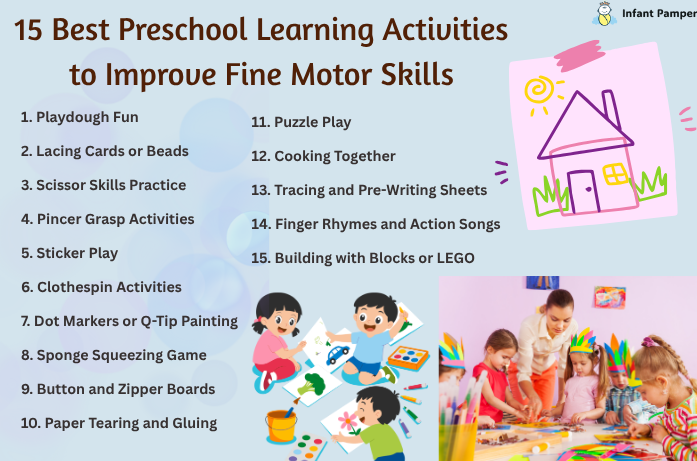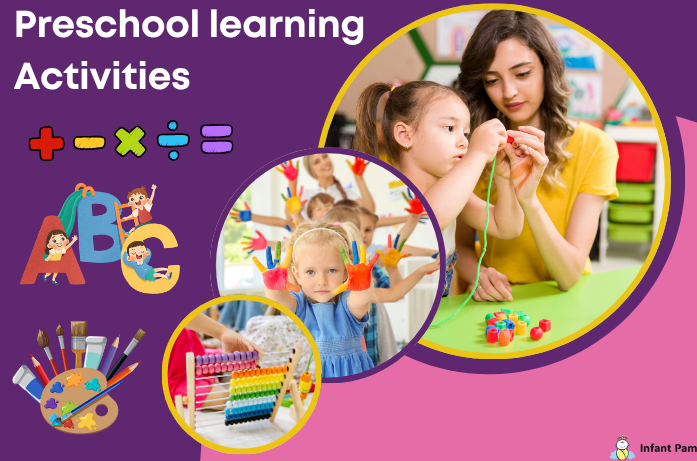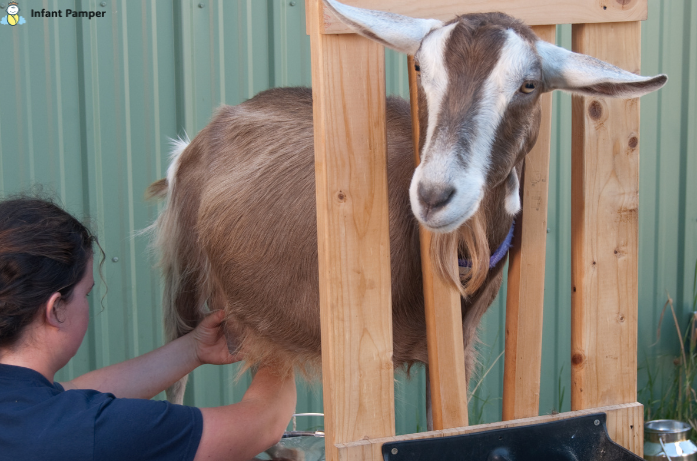By a Caring Mom at Infant Pamper
Fine motor skills are one of the main continuing developments in a child’s infancy. These tiny but mightily powerful movements of grasping, pinching, twisting ensure that your toddler will eat by himself, hold the pencil, or button up clothes. For preschoolers, the development of these skills means laying the groundwork for future success in writing, self-care, and school activities.
we will look at what fine motor skills are, why they are important, and the best preschool learning activities that can embellish those skills, all based on erupting research insight coupled with outside-the-box creative thinking.
What Are Fine Motor Skills?
The term fine motor skills describes the coordination of small muscles in the hands, fingers, and wrist of a child that work together with the eyes to perform tasks requiring precision and control. To name a few examples:
- Holding crayons or pencils
- Using scissors
- Buttoning up clothes
- Turning book pages
- Stacking blocks
- Feeding themselves
When developed, fine motor skills pave the way for independence and readiness in early writing and educational preschool activities.
Why Fine Motor Skills Are Important in Preschool
The preschool stage (ages 3–5) plays an important part in fine motor coordination. Children begin to use tools in this stage: pencils, forks, or scissors. The American Occupational Therapy Association (AOTA) states fine motor development is essential for school readiness and daily independence. The National Association for the Education of Young Children (NAEYC) also highlights the role of hands-on preschool activities in building confidence and independence.
Effects of Fine Motor Delays on Your Child May Include
- Problems writing, drawing, or coloring
- Hard time dressing on its own (i.e., buttoning or zipping)
- Difficulty using scissors correctly or holding crayons
- Avoiding activities that require fine motor skills, such as coloring or tracing
- Inability to play with puzzles, stacking toys, or building blocks
- Lower self-esteem or frustrated feelings in the classroom
Signs Your Preschooler May Need More Fine Motor Practice
Every child grows at their own pace, but if you notice multiple signs below, it may mean your child could benefit from more daily fine motor practice:
- Awkward or improper pencil/crayon grip
- Avoids tasks involving hand coordination (like coloring or writing)
- Frustration with dressing skills (buttons, snaps, zippers)
- Difficulty cutting with child-safe scissors
- Trouble manipulating small objects or completing puzzles
Tip: If you observe several of these signs, then daily preschool activities at home should be incorporated into the child’s routine. Regular practice in a playful manner will allow natural development of strength, coordination, and confidence.For more guidance on early motor development and milestones, parents can explore trusted resources likePathways

15 Best Preschool Learning Activities to Improve Fine Motor Skills
Let us see some fun, hands-on preschool learning activities for 3–5 year olds to work on finger strength, dexterity, and coordination.Play-based activities are widely recommended by child development experts, and organizations such as UNICEF emphasize how learning through play supports not only motor skills but also social and cognitive growth in children.
1. Playdough Fun
- Rolling, squeezing, and shaping playdough strengthens hand muscles.
- Add child-friendly tools such as scissors, rolling pins, and cookie cutters.
- Have fun making your own non-toxic dough in the kitchen!
2. Lacing Cards or Beads
- Beading improves coordination and pincer grasp.
- Begin with big beads and then go on to smaller beads.
3. Scissor Skills Practice
- Have your child use his or her child-safe scissors to cut pictures out of magazines or newspapers.
- Draw “cutting lines” for them to follow on a sheet of paper.
Note: Always keep an eye on the child when scissors are being used.
4. Pincer Grasp Activities
- Pick up pom-poms or pasta and transfer these from container to container with tweezers.
- Pick up small buttons, beads, or mini erasers between finger and thumb.
5. Sticker Play
- Peeling and placing stickers strengthen the small finger muscles.
- Try using sticker books or create your own sticker matching games are fun educational preschool activities.
6. Clothespin Activities
- Allow your child to clip clothespins to a string or along an edge of a cardboard.
- These may be numbered or color-coded for further learning.
7. Dot Markers or Q-Tip Painting
- Excellent for the development of good wrist control.
- Drawing shapes with soft cotton swabs dipped in paint is also a great sensory experience.
8. Sponge Squeezing Game
- Fill two bowls with water and place a sponge between them.
- Your child now has to transfer water from one bowl to the other using only the sponge.
9. Button and Zipper Boards
- Practice fastening skills on the boards or from the old clothes.
- This promotes independence in dressing, which is a big win for school readiness activity.
10. Paper Tearing and Gluing
- Tear strips of colored papers and glue them to create collages.
- They develop hand muscles and increase creativity.
11. Puzzle Play
- Wooden puzzle, shape sorting, and pegboards help with gripping and coordination.
- Pick puzzles suited to your child’s age and ability.
12. Cooking Together
- Stirring, pouring, and sprinkling are real-life preschool learning activities at home.
- It is a good fine motor exercise in real life with a bonus of bonding time.
13. Tracing and Pre-Writing Sheets
- Encourage tracing simple lines, shapes, and letters.
- Use crayons, pencils, or fingers in sand or rice trays.
14. Finger Rhymes and Action Songs
- Songs like “Itsy Bitsy Spider” or “Open, Shut Them” encourage finger movements and timings.
15. Building with Blocks or LEGO®
- Building can promote bilateral coordination (working both hands together).
- Start with larger blocks and move on to smaller blocks as the child’s skills improve.
Making These Activities Part of Your Daily Schedule
To get the results, one should engage in 15 to 30 minutes of fun preschool activities, fine motor play every day. It does not necessarily have to be consecutively in one session. It can be broken alongside:
- Morning routines (buttoning, zipping)
- Art time (cutting, coloring)
- Playtime (blocks, puzzles)
- Mealtime (pouring, peeling)
Follow your child’s interests. When they love stickers, spend more time on sticker activities, but if they’re into imaginative play, add dress-up with zippers and snaps.
How to Know Fine Motor Skills Are Improving
You will know they are getting better when:
- Using a proper pencil grasp
- Coloring or drawing confidently
- Finishing puzzles all by themselves
- Trying to dress or feed themselves
- Feeling proud of finishing something
Celebrate the smaller victories. Encouragement builds confidence, which leads to greater engagement and faster growth in early learning activities.
Final Thoughts
The preschool years are the perfect period for building a strong foundation for lifelong learning and independence. Fine motor development is a subject with regard to schooling, but more importantly, it is about giving the child the tools to explore this world with confidence and control.
Play-with-a-purpose was what I called it. Anything that turns your child into opportunities for grasping and giggling will do. More than anything, with patience, encouragement, and the right preschool learning activities, you will be amazed at what these tiny hands begin to accomplish.
Frequently Asked Questions (FAQs)
Q. 1 What are fine motor skills in preschoolers?
Fine motor skills involve small movements of the hand and fingers that help children with writing, cutting, and buttoning clothes.
Q. 2 Why are fine motor skills important for early childhood development?
They ensure the development and performance of necessary skills such as handwriting, feeding skills, dressing, and being ready for school by fostering coordination and independence.
Q. 3 How can I help my child develop fine motor skills at home?
Simple preschool activities at home comprising playdough play, using scissors, bead stringing, puzzles, and shape tracing form activities for developing fine motor strength and control.
Q. 4 How do I know if my child requires support for fine motor skills?
Difficulty in handling crayons, writing aversions, problems with using scissors or zipping, and frustration over tiny tasks may require practice.
Q. 5 How often should we do fine motor activities?
15 to 30 minutes daily of fun preschool learning games best. Make it fun and appealing to your preschooler so they will remain interested and get better.
Disclaimer: This article is meant for educational purposes only. It is not a substitute for any professional medical advice or occupational therapy. If you feel medical concerns on your child’s development, please consult your pediatrician or any certified therapist.
Start today with simple, fun, and purposeful preschool learning activities that nurture growth and confidence in your child! Be it playdough time, puzzling, or sticker fun; every little step counts.
Check out more expert parenting tips and early learning guides at Infant Pamper, the partner you can trust on every milestone.




